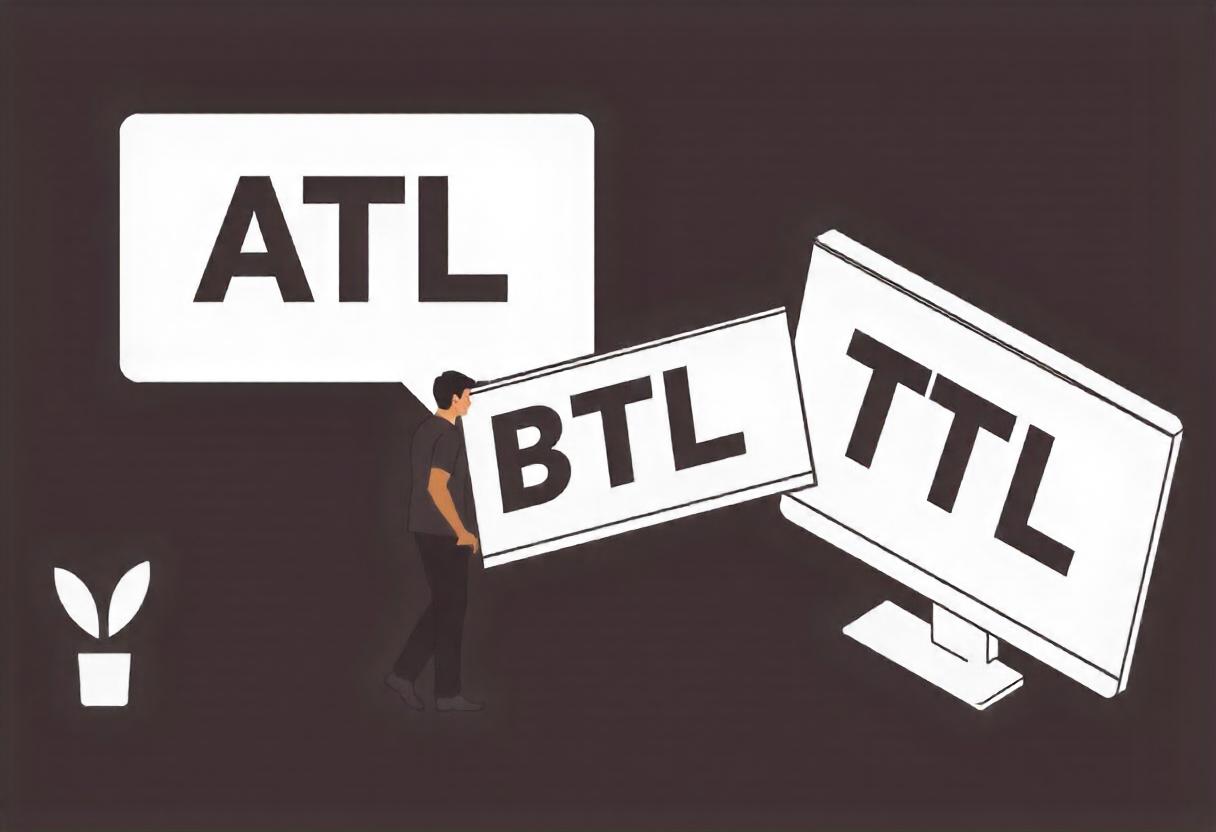naaaWhat distinguishes “above the line,” “below the line,” and “through the line” marketing is a subject that is frequently posed in the marketing community.
Above the Line, or ATL Marketing, describes broad, often untargeted campaigns to increase brand awareness and reach a larger audience. Below the Line, or BTL Marketing, is the much more focused and smaller world of advertisements, targeted at specific individuals and with easily trackable returns on investment and a defined audience. And finally, through the Line, as you can imagine, combines both of these strategies to achieve both broad brand awareness and focused, targeted returns.
What exactly is “the Line” and how did it originate?
These definitions of marketing tactics were first used in 1954, when Proctor and Gamble began paying different firms separately and at different rates for direct promotional efforts and larger advertising campaigns, thereby distinguishing the two approaches.
In this way, advertising firms employed ‘the Line’ in marketing to distinguish direct, focused campaigns from those more generic and extensive aimed at brand awareness, as well as those with or without direct outcomes and direct return on investments.
The is reason to wonder if ‘the Line’ is now blurring; for example, the widespread usage of social media today and the exposure it provides means that advertising here should be ATL, but it may also be highly targeted (BTL), so is all social media TTL? One essential factor to examine is intent. If you are offering a promotion or something with a direct response aspect, it cannot be ATL; instead, TTL requires the promotion to be on a page that is not as targeted.
We will now look more closely at the typical marketing methods.
Above the Line Marketing (ATL)
ATL are marketing activities that are primarily used to increase brand awareness and goodwill. They are broad campaigns that are essentially untargeted and carried out at a general level. A national, or even global, TV ad campaign in which the same advertisement is seen to people of all demographics is an excellent example of an ATL Marketing technique. Instead of targeting certain people who have previously been recognized as possible buyers, the goal of the advertisement is to widen a brand’s horizons, reach more people, and identify themselves more clearly and with a clear image.

Above the Line Marketing (ATL)
Other examples are print media and radio broadcasts, which reach a big number of people and thus provide access to a large market of potential buyers.
Examples of Above-the-Line Promotions
Television
Television is among the most common mediums of advertising. People watch television because it is entertaining and informative. They are able to see what you do, where you live, and how much you earn. If you want to reach people, you must use above-the-line advertising.
Companies pay for above-the-line adverts. This style of advertisement comprises commercials, infomercials, public service announcements, and product placements. These types of commercials are more expensive, but they increase interest in your brand.
You can select from a variety of adverts to include in your above-the-line campaign. Here are few examples:
– Local ads: These are typically displayed on billboards, bus stops, and so forth. They are frequently observed around where humans reside.
– National advertising are often viewed during prime time or late at night. They are frequently seen on cable news stations such as CNN and Fox News.
– International ads: These advertisements appear on foreign television networks such as BBC World News and Al Jazeera English.
Print Media
Print media includes newspapers and periodicals. The primary goal of employing print media is to reach a big number of people rapidly. This strategy has been utilized for decades, but more individuals are turning to the internet to get content online.
Radio
The advertising technique on radio is one of the most traditional and efficient kinds of advertising. Radio advertisements are often effective at increasing customer recall and prompting action. Furthermore, they might be aimed at a local, national, or international customer base.
ATL is an effective technique to promote and expand your brand, but it is tough to determine the actual impact and return on investment. This is why it is more untargeted; the goal is not to achieve a specific conversion rate, but to raise customer awareness of your brand or product and boost your visibility.
Below the Line Marketing (BTL)
However, BTL is utilized in the opposite way as ATL. Below the Line Marketing is directed at specific individuals who have been recognized as potential clients. Popular BTL techniques include outdoor advertising (billboards and fliers), direct marketing (email and social media), and event sponsorship. The latter is very popular because providing a memorable experience to your potential clients makes your brand more memorable, and people are more likely to like it.

Below the Line Marketing (BTL)
Examples of Below the Line Promotion
Direct Mail
Direct mail marketing is an effective approach to reach out to potential customers. It typically entails printing big amounts of material in mass, addressing envelopes, and mailing them to recipients. This sort of marketing is commonly employed by businesses who want to deliver promotional materials directly to customers.
For example, older generations prefer to get physical materials such as catalogs, flyers, and brochures, which can be distributed through delivery services. This is why they are still popular among marketers, since they allow them to target certain demographics and customer segments while still personalizing their ads.
Sponsorship
Sponsorship helps to ensure that adverts are viewed by their intended audience. It also enables firms to reach new consumers, increase publicity, and strengthen their reputation.
Trade Shows and Exhibitions
Direct mail campaigns are especially effective for promoting your business during trade exhibitions since they allow you to contact potential clients who might be interested in attending your event. Offering crucial promotional messaging, such as special discounts or other incentives for joining, will boost conversion rates and attraction efficiency.
However, today’s firms want to take advantage of e-mail marketing and internet promotions, which are less expensive and take less time than old approaches like direct mail.
Email Marketing
In today’s digital age, email is a very effective tool to communicate with customers. In fact, it is one of the most economical ways of marketing. Direct mail campaigns are expensive since you have to pay for printing and postage beforehand, but email marketing is free to send out. You simply pay for each recipient’s inbox, and because you know how many receivers there are, you can determine your ROI.
The efficiency of email marketing efforts is simple to assess. For example, you can utilize analytics software to track open and click rates and compare them to prior campaigns. If a campaign creates increased traffic, it indicates that your audience is responding positively to the messages.
Targeted Search Engine Marketing
Online marketing allows firms to target their advertising efforts using keywords and other business-related search queries. This enables them to create leads who may be interested in their offerings. The most effective way to use these tools is to develop ads that target specific keywords.
Paid search ads can be a cost-effective solution for b2b businesses. They let you to advertise your products online without having to pay upfront for costly print adverts. Instead, you pay when someone clicks on one of your advertisements.
In-Store Promotion
In-store marketing is a prevalent practice in retail businesses and another example of below-the-line operations. Visual merchandising, retail pop-up stores, sampling, point-of-sale (POS) displays, and sales promotions are all excellent methods for encouraging customers to buy your products and increasing ROIs.
Unlike ATL, BTL is heavily focused on targeting individual advertising to specific people, ensuring that the content and location align as closely as possible with the purpose of these potential customers. BTL also differs in that it prioritizes return on investment (ROI), user conversions, and success measurement. Instead of simply raising brand recognition, BTL is intended to generate direct consumer demand for the product or brand by concentrating on the user and their needs. This type of engagement marketing is typically fairly quantitative, with the added benefit of highly trackable results.
Through-the-Line Marketing (TTL)
Finally, we get to Through the Line Marketing, or TTL Marketing. This combines ATL and BTL Marketing’s broad audience and direct approaches in an attempt to boost brand awareness while also targeting individual potential customers and converting them into measurable and quantifiable sales.

Through-the-Line Marketing (TTL)
One example is 360-degree marketing, which combines a nationwide TV campaign with tailored flyers and newspaper ads. Another example of TTL Advertising is the usage of Digital Marketing, which involves integrating online banner ads with social media posts and blogs. With these advertising methods and an integrated marketing approach, you’ll be sure to reach a wide spectrum of your target demographic.
Digital Marketing Strategies
Through-the-line marketers rely on social media sites such as Facebook, Twitter, and Instagram to reach out to customers directly. They also offer interactive media for sharing information about new items and promotions. TTL marketers may use these platforms to develop customer relationships, which leads to more sales. More specifically, digital distribution is critical in today’s technologically evolved environment.
The clear advantage of a TTL approach is that you are hitting two fronts at once: boosting public awareness while also seeking to improve traffic and sales.
So, what’s the difference between ATL, BTL, and TTL? Above the Line Marketing refers to advertising operations that are mostly untargeted and directed at a vast number of individuals in order to boost overall brand awareness and image, despite the difficulty of quantifying outcomes and ROI. Below the Line Marketing is more targeted at potential customers, providing them with material that speaks to them and making it more easier to see the impact it makes. Through the Line Marketing entails combining both tactics to target specific individuals and impact a larger number of people on a broader scale while providing measurable data on its impact, which is pricey and so typically utilized by financially stable businesses.
When deciding between ATL, BTL, and TTL, you should examine your budget, target market, and rivals. If you want to grow a long-term business, you should focus on developing a solid consumer base through TV commercials or other ATL tactics.
Large organizations will often invest in traditional media such as television, radio, and print, whereas small- to medium-sized enterprises may choose to spend their marketing budget on digital channels such as social media, email, or online campaigns because they are more cost effective. As a result, the marketing strategy you choose will be heavily influenced by the nature of your organization and its goals.



